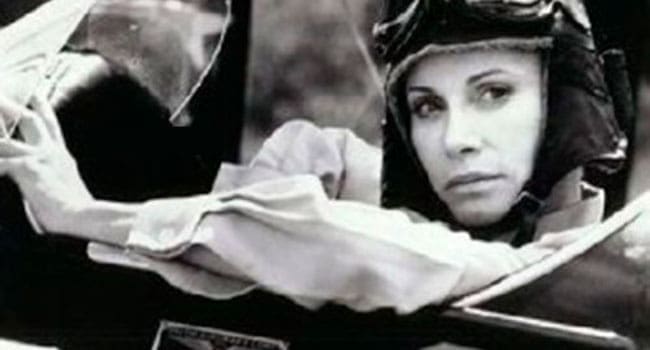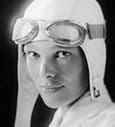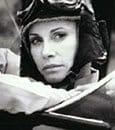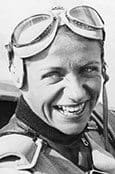 Although it’s been 80 years since she went missing, Amelia Earhart still captures attention. Just last week, there was a report on an impending effort to locate whatever may be left of her. As the headline put it, “Bone-sniffing dogs will search for Amelia Earhart’s remains on remote island.”
Although it’s been 80 years since she went missing, Amelia Earhart still captures attention. Just last week, there was a report on an impending effort to locate whatever may be left of her. As the headline put it, “Bone-sniffing dogs will search for Amelia Earhart’s remains on remote island.”
Earhart’s fame is a relic of a bygone era, a time when aviation was new and flyers were seen as daredevils. Charles Lindbergh was the most famous of all but Earhart gave him a run for his money in the 1930s.
Born in 1897 Kansas, Earhart caught the flying bug in 1920 and earned her pilot’s licence in 1923. In 1932, she became the first woman to fly non-stop solo across the Atlantic, emulating Lindbergh’s achievement of five years earlier.
Leaving from Newfoundland, Earhart had intended to fly to Paris. However, thanks to adverse weather and mechanical difficulties, she landed in a farmer’s field in County Derry, Ireland, just under 15 hours after take-off. Still, she’d crossed the Atlantic alone.
Five years later, Earhart and her navigator, Fred Noonan, set out to circumnavigate the globe. On July 2, 1937, they left New Guinea for a lengthy leg designed to take them to what has been described as “a tiny speck in the mid-Pacific called Howland Island.” Then they disappeared.
When a hitherto unprecedented air and sea search failed to turn up any signs, it was concluded that the plane had run out of gas, crashed into the sea, and sank without trace in the deep Pacific waters. But not everyone was convinced and various theories circulated for years.
The one at the heart of the most recent story holds that Earhart landed on a reef at Nikumaroro (Gardner Island), which was then uninhabited and is now part of the Republic of Kiribati. There, so the theory goes, she and Noonan perished as castaways. Hence the search for her bones.
Earhart may have been the most famous female flyer of the era but she wasn’t the only one.
Born in 1902 England to Charles and Clara Clutterbuck, Beryl Markham was brought up in colonial Kenya. While horses were her first love, she also caught the flying bug.
After getting her licence in 1931, Markham spent several years as a bush pilot in Africa. Then, in 1936, she became the first person to fly solo from England to North America.
It was a difficult flight in appalling weather and against the prevailing winds. And, like Earhart before her, Markham landed short of the original destination. Instead of touching down in New York, she crash-landed in a Nova Scotia bog.
Markham, though, was noted for more than her flying.
Blonde and nearly six-feet tall, she was described as “a magnificent creature, very feline. It was like watching a beautiful golden lioness when she walked across the room.”
Imbued with the easygoing sexual mores of Kenya’s Happy Valley set, Markham was a prodigious collector of men. In addition to three failed marriages, she “embarked upon dozens of love affairs, some passionate, some just to pass the time of day.”
One of these assignations involved Prince Henry, then third in line to the British throne. To Markham, it was just a “mad little gallop.” Buckingham Palace, however, took a less benign view.
Finally, let’s not forget Germany’s Hanna Reitsch.
Celebrated by aviation enthusiasts as the first woman to fly a helicopter, Reitsch also had the distinction of being Adolf Hitler’s favourite aviatrix. And the admiration was mutual.
Spending two days in Hitler’s Berlin bunker as the Red Army tightened the noose in April 1945, Reitsch regretted not dying with her fuehrer. But she accepted her orders, flew out on a mission and went on to enjoy a reasonably distinguished post-war career.
While Earhart, Markham and Reitsch were very different people, they had a couple of things in common.
As women growing up in the first-half of the 20th century, they knew what they wanted and went after it. Aviation may have been seen as an exclusively male club, but none of the three could be deterred.
They were also very brave. Flying the Atlantic solo or negotiating an improvised 1945 Berlin airstrip weren’t activities for the faint of heart.
Mind you, determination and courage don’t necessarily make one wise.
Troy Media columnist Pat Murphy casts a history buff’s eye at the goings-on in our world. Never cynical – well perhaps a little bit.
The views, opinions and positions expressed by columnists and contributors are the author’s alone. They do not inherently or expressly reflect the views, opinions and/or positions of our publication.




